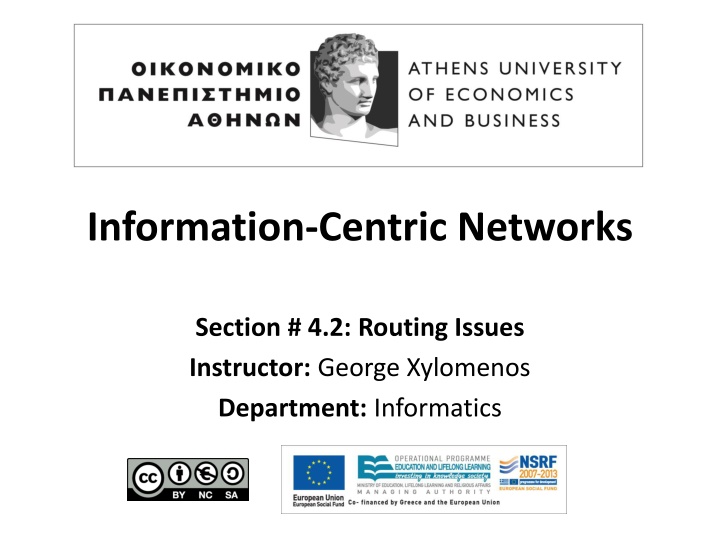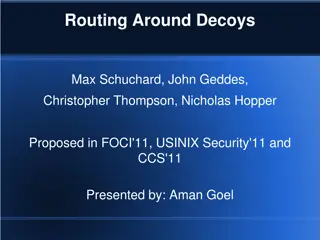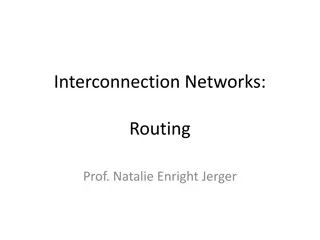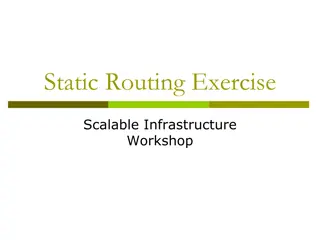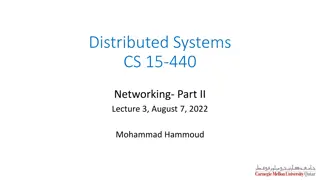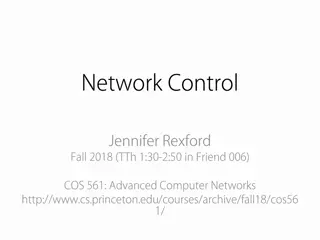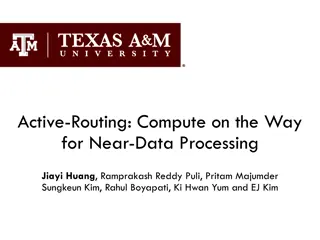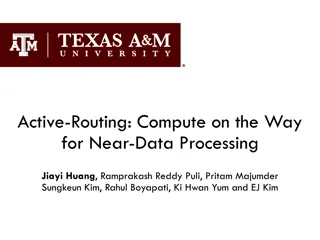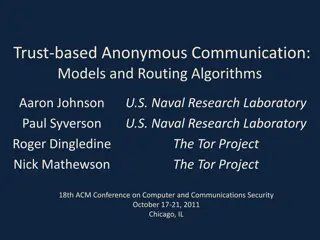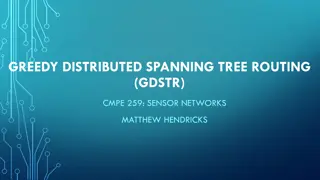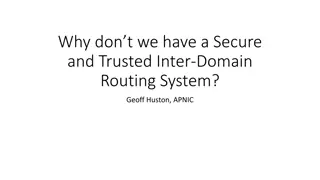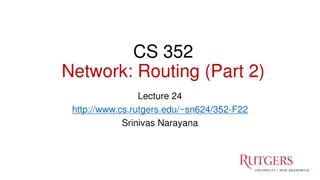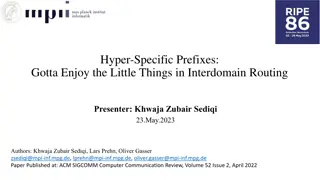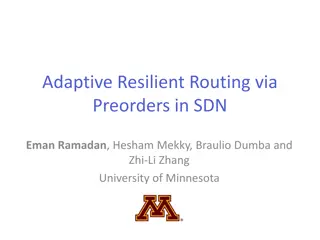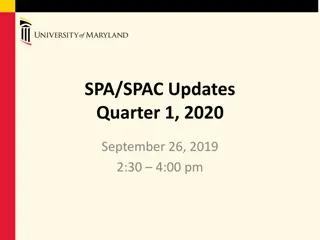Routing Issues in Information-Centric Networks
In Information-Centric Networks, routing issues can lead to disruptions in connectivity, such as BGP misconfigurations causing Internet connectivity problems. This study explores the frequency, causes, and impacts of misconfigurations in BGP tables, highlighting the importance of addressing such issues to ensure stable network operation and enhance user experience.
Download Presentation

Please find below an Image/Link to download the presentation.
The content on the website is provided AS IS for your information and personal use only. It may not be sold, licensed, or shared on other websites without obtaining consent from the author.If you encounter any issues during the download, it is possible that the publisher has removed the file from their server.
You are allowed to download the files provided on this website for personal or commercial use, subject to the condition that they are used lawfully. All files are the property of their respective owners.
The content on the website is provided AS IS for your information and personal use only. It may not be sold, licensed, or shared on other websites without obtaining consent from the author.
E N D
Presentation Transcript
Information-Centric Networks Section # 4.2: Routing Issues Instructor: George Xylomenos Department: Informatics
Funding These educational materials have been developed as part of the instructors educational tasks. The Athens University of Economics and Business Open Courses project only funded the reformatting of these educational materials. The project is being implemented as part of the Operational Program Instruction and Lifelong Learning and is co- financed by the European Union (European Social Fund) and national funds.
Licencing These educational materials are subject to a Creative Commons License.
Week 4 / Paper 2 Understanding BGP Misconfiguration Rahil Mahajan, David Wetherall, Tom Anderson ACM SIGCOMM 2002 Main point BGP misconfiguration can disrupt Internet connectivity How often does it occur? Why does it occur? Observation from multiple vantage points 200-1200 prefixes misconfigured each day Users are affected by very few of them Information-Centric Networks 04b-4
Introduction Focus on two types of misconfiguration Accidental injection of routes into BGP tables Accidental export of routes in violation of policy Goals of the study How often are misconfigurations? What is their impact on connectivity and load? Why do they occur? How can they be reduced? Observation study 23 vantage points during 21 days Use of simple heuristics to identify errors Polling of operators to verify causes Information-Centric Networks 04b-5
Misconfiguration Focus on two types of BGP misconfiguration Origin misconfiguration: erroneous injection in BGP tables Failure to summarize prefixes Announcing someone else s address space Propagation of private prefixes Export misconfiguration: advertisement of policy violating routes There are many other types of misconfiguration These are externally visible and clearly against policy Adverse impacts of misconfiguration Increase of routing load due to unnecessary updates Partial or global connectivity disruption Routing policy violations Information-Centric Networks 04b-6
Methodology Analysis of data from the RouteViews BGP listener 45% of new routes last for less than a day 30% of new routes last for more than 7 days Inference: misconfigurations last for less than a day Requires verification by operator polling Result: a lower bound on actual misconfigurations Origin misconfiguration analysis Examination of new routes (not reappearing ones) Self deaggregation: possible aggregation error Related origin: possible backup route Foreign origin: possible address hijacking Look for routes that disappear quickly More likely to be an error that was noticed Information-Centric Networks 04b-7
Methodology Export misconfiguration analysis Paths are normally valley free Up to the core, through the core and down to the destination We can only infer the AS relationships via BGP tables Result: a lower bound on actual misconfigurations Types of misconfiguration Provider->AS->Provider Provider->AS->Peer Peer->AS->Provider Peer->AS->Peer Verification: email to operator and connectivity testing Emails often bounced due to erroneous data in registries Test reachability of suspect AS s from multiple vantage points Information-Centric Networks 04b-8
Results Origin misconfiguration Short lived routes were clustered into incidents Sets of prefixes from the same AS that appear/disappear together Up to 72% of new routes seen in a day are misconfigurations Extrapolation from the e-mail answers for incidents Connectivity tests matched well with e-mail responses 13% of the incidents impact connectivity Some of the connectivity problems were not noticed by operators! Extrapolation: 25 incidents per day disrupt connectivity 50% of misconfigurations last less than 10 minutes 80% less than an hour, 90% less than 10 hours Connectivity disruptions are fixed sooner Information-Centric Networks 04b-9
Results Export misconfiguration Segments with policy violations were clustered into incidents Most incidents do not affect connectivity, only load Provider->AS->Provider is the most common violation Followed by Provider->AS->Peer Impact on load is normally low But it can even double load in some incidents Information-Centric Networks 04b-10
Causes Classification of human errors Slips: errors in executing a correct plan Mistakes: correct execution of an erroneous plan Origin misconfigurations Mistakes Initialization bugs: bug in a specific vendor s product Reliance on upstream filtering: response to attacks of load balancing Old configuration: unsaved changes or backup routers Slips Redistribution: of internal routes Community: incorrect scoping of routes Hijack: of addresses prefixes (attack or typing error) Forgotten filter: error in filtering Incorrect summary: larger or smaller address blocks Information-Centric Networks 04b-11
Causes Export misconfigurations Mistakes Prefix based configuration: a backup path leads to transit violations Old configuration: as in origin misconfigurations Initialization bug: as in origin misconfigurations Slips Bad ACL or route map: obvious Typo: obvious Forgotten filter: as in origin misconfigurations Community: as in origin misconfigurations Information-Centric Networks 04b-12
Discussion What can we do to reduce misconfigurations? User interface design Many CLIs are problematic and should be improved Often operators do not really understand the CLI High-level languages and checking Router configuration is a very low level task At least high level configuration checking would be good Database consistency and replication Registries are very outdated, leading to errors Protocol extensions Secure BGP guards against hijacks Better error reporting would reveal many other errors Information-Centric Networks 04b-13
End of Section # 4.2 Course: Information-Centric Networks, Section # 4.2: Routing Issues Instructor: George Xylomenos, Department: Informatics
